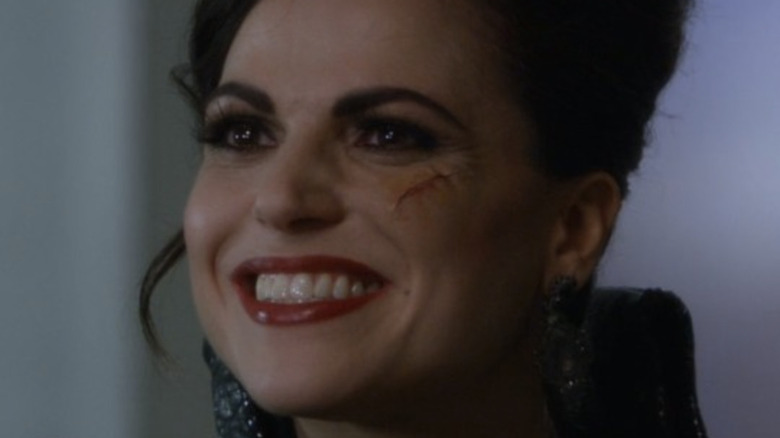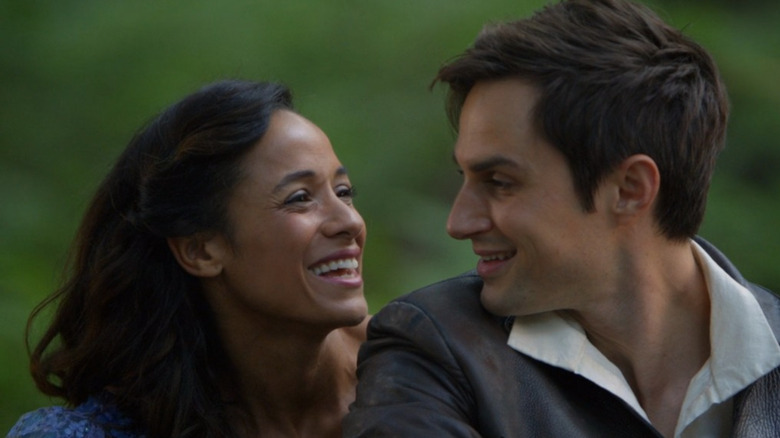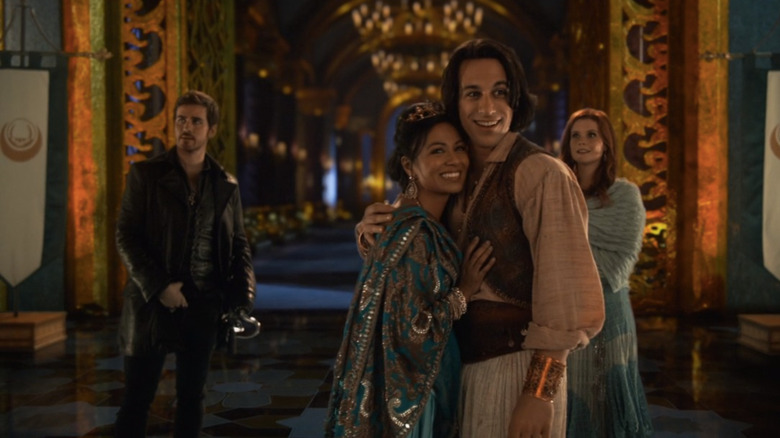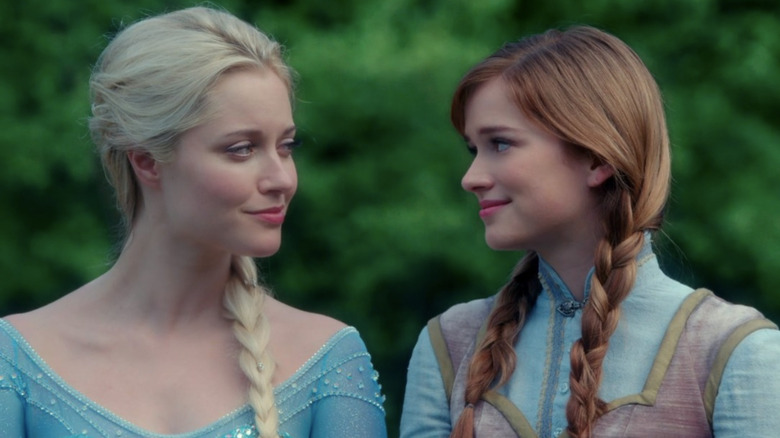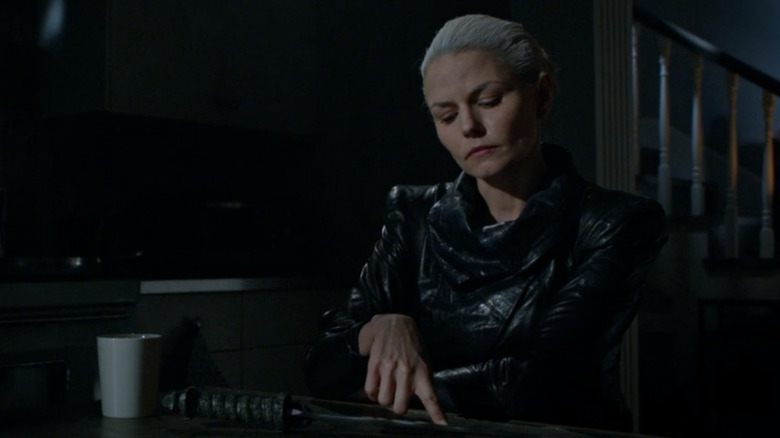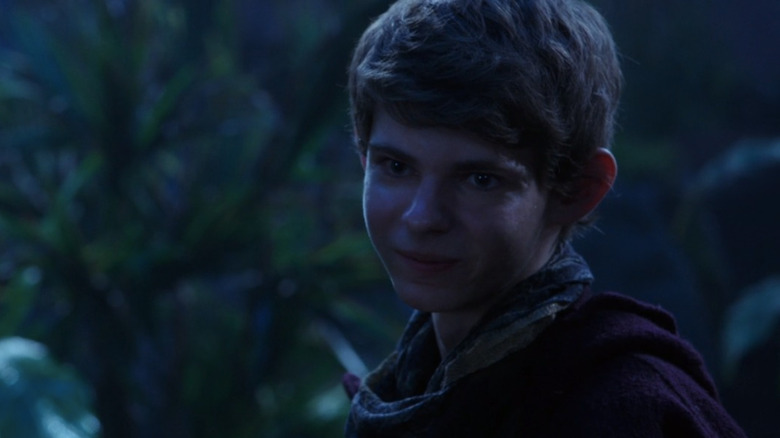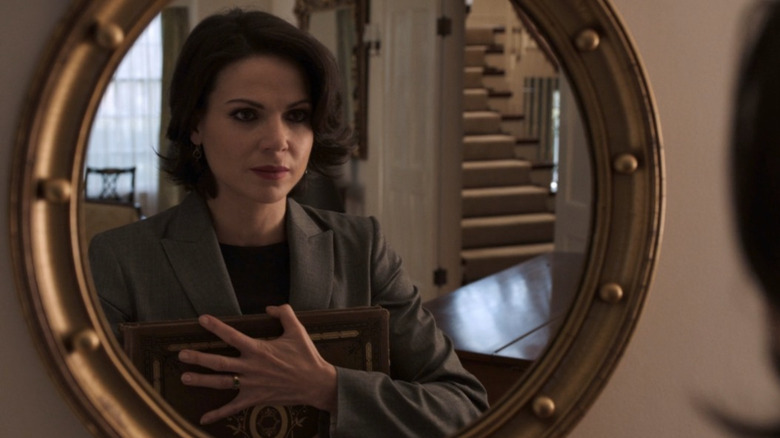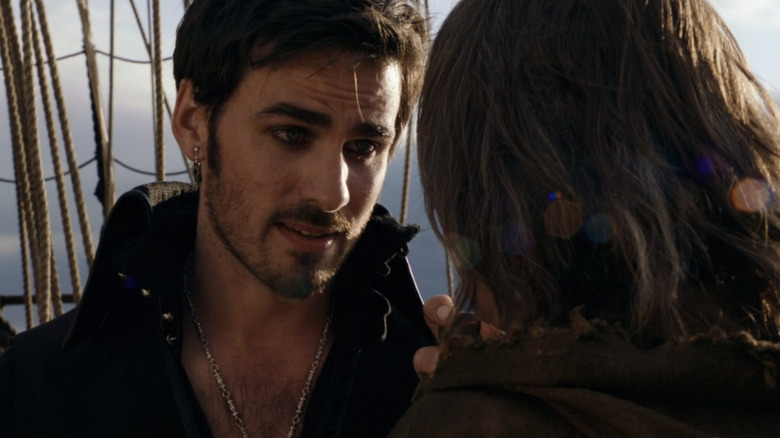Every Season Of Once Upon A Time Ranked Worst To Best
"Once upon a time ... There was an enchanted forest filled with all the classic characters we know. Or think we know. One day they found themselves trapped in a place where all their happy endings were stolen. Our World. This is how it happened... " These words on a plain black screen open the beginning of the very first episode of "Once Upon a Time," the primetime fairytale drama that aired for seven seasons on ABC from 2011 through 2018.
Over the course of the series, audiences discover new personalities and surprise identities of classic characters, some based on their centuries-old origins in fairytales penned by the Brothers Grimm with others more closely resembling their counterparts from animated Disney movies. The series contains an abundance of characters and plentiful narrative twists. "Once" was created by Edward Kitsis and Adam Horowitz, former writers on "Lost" who imbued the canvas of "Once Upon a Time" with the brisk pacing and surprise plot points associated with their previous show.
"Once" covers a lot of ground in its seven seasons. More often than not it dazzles with cleverness and an epic scale, thanks in large part to its ability to expertly leverage the vast collection of intellectual property owned by ABC's parent company, Disney. On that note, let's take a drive in Emma Swan's Volkswagen Beetle and head to Storybrooke to rediscover some favorite moments and occasional pitfalls that made "Once Upon a Time" a cornerstone of 2010s fantasy TV. Here are all seven seasons ranked.
7. Season 7
The final season of "Once Upon a Time" begins with a sincere hope that it might be the start of an entirely new era for the series. With the feel of a reboot rather than a continuation, the story jumps ahead to follow 30-something adult Henry Mills, who spends the first six seasons as a teenager, cursed to a town called Hyperion Heights, Washington, and forgetful of his true identity.
A few familiar faces return for Season 7, but much of the cast is new. The late additions all resonate as earnest in their efforts but struggle to replace the former mainstays. Narratively, the show gets confusing as it asks viewers to keep straight multiple versions of different characters. Among the standouts is Princess Tiana from "The Princess and the Frog," finally making her "Once" debut along with several other characters from the 2009 Disney film. The most fun twist of the season depicts Rapunzel, locked in a tower for her entire youth, growing up to be Lady Tremaine, later noted for locking Cinderella in a tower.
While the do-over premise of Season 7 didn't quite come together and the show was ultimately cancelled, its final stretch becomes a celebration of what made the show great for seven years. Most of its original cast returns for the series finale, which ends with Regina crowned the Good Queen over all the fairytale realms, now united in close proximity to one another.
6. Season 6
The show's penultimate season struggles to find an identity among overused fantasy tropes and an ensemble that feels mostly ready to move on from the series. The lore of the show and the rules of its story are continually abridged and rewritten in Season 6, which introduces what's now commonly recognized as a multiverse riddled with storytelling nuances.
The "Once" multiverse sets the groundwork for one of the season's central and most thrilling moves — the return of the Evil Queen. With Regina having undergone a redemptive arc in earlier seasons, it would be regressive for her character to revert back to her nefarious ways. But the newfound benevolent disposition of Lana Parrilla's character wastes the actor's fantastic ability to play a villain. The show resolves this conundrum by splitting Regina into two characters — one good, the other evil — both played by Parrilla. Another Season 6 highlight is the long-awaited introduction of Aladdin and Jasmine to the series, both of whom have recurring roles and face off against Jafar.
Rumpelstiltskin's mother serves as primary villain for most of the season's second half. She continually teases the "final battle" with which the season culminates. Much of the principal cast would depart the series after Season 6, but nevertheless, the logic of a "final battle" doesn't really hold up, given that there are many more battles ahead. Season 6 also brings us the love-it-or-hate-it musical episode.
5. Season 4
In November of 2013, "Frozen" premiered in movie theaters. By fall of 2014, the film was nothing short of an international phenomenon. It became the highest-grossing animated film ever up to that point, swept the charts with its award-winning music, and naturally worked its way into the many different divisions of Disney at the company's disposal. It wasn't long before Disney announced more "Frozen" projects for the big screen, theme parks, the Disney Channel, and Elsa and Anna joining Disney's other famous princesses on ABC's "Once Upon a Time."
The result is the first half of Season 4 of "Once" is essentially a "Frozen" live-action limited series. Its story integrates into the ongoing narrative of Storybrooke with its established series regulars, but simultaneously tells its own self-contained "Frozen" arc. Unlike some fairytale characters that "Once" reimagines for the series, the "Frozen" gang are depicted as almost verbatim versions of their counterparts in the animated feature. Anna, Elsa, Kristoff, Hans, and even Oaken all make appearances. The season's villain is Ingrid, a new character linked to Elsa's past, portrayed by Elizabeth Mitchell.
The season is earnest in its stewardship of "Frozen," with a story that makes sense for both Arendelle and Storybrooke. For viewers, it's a milage may vary situation contingent on their individual enthusiasm for a completely different franchise taking over "Once" for a while. The season's second half is unmemorable by comparison, focusing on villains Maleficent, Cruella De Vil, and Ursula forming a group called the "Queens of Darkness."
4. Season 5
The show's fifth season includes some magical storytelling, with its first half centered in Camelot and its back half focused on Hades from "Hercules." The plot points in this season sometimes feel outlandish, with its most over-the-top aspects including Emma Swan becoming the "Dark One" and the significant time the season spends in literal hell. Still, the season's focus on the Underworld — a place where those with "unfinished business" are sent when they die — allows for multiple callbacks to characters from former seasons, which can be fun for longtime fans.
Notably, Season 5 is also the first time the series includes a relationship representing the LGBTQ+ community, with Red Riding Hood and Dorothy Gale getting together. Season 3 reveals that Mulan was in love with Aurora, but the characters never pursue a relationship.
Characters introduced in Season 5 include King Arthur, Hercules, Megara, and the only Pixar character to appear on the show, Merida from "Brave." But for the most part, whereas Season 4 leans all the way into its Disney heritage, Season 5 swings the pendulum in the opposite direction. The Camelot arc is just as influenced by Arthurian legends and literature as it is Disney's animated King Arthur movie, 1963's "The Sword in the Stone," and the Underworld episodes are more of a tribute to the history of "Once" itself rather than any other specific franchise.
3. Season 3
The series' first attempt to divide a broadcast season into two halves brings us two fantastic story arcs — one focused on "Peter Pan" and the other on "The Wizard of Oz," each with its own set of twists. The Neverland episodes send us for a swerve when they reveal Peter Pan as both a villain and Rumpelstiltskin's father. It's the first time an extended string of episodes takes place beyond Storybrooke's borders and functions as a welcome change of pace. The season's second half introduces Zelena, aka the Wicked Witch of the West. She's also the sister of Regina, the Evil Queen, and the villain sibling rivalry marks an exciting progression for Regina and the series as a whole.
Season 3's mid-season finale, "Going Home," is one of the best overall "Once" episodes and could pass for a series finale. Its stakes are high and its ending is somewhat tragic, with a new curse protecting the townspeople of Storybrooke while banishing Emma Swan to a happy life elsewhere with no memory of her real family.
The last episode of Season 3 concludes with one of the series' best cliffhangers. First, viewers learn that Robin Hood's wife, Maid Marian, is actually alive, putting a damper on Robin and Regina's new relationship. Mere moments later, the show reveals another new arrival to Storybrooke: a blonde woman in a blue dress who shoots ice out of her palm. Ending the season with a twist, Queen Elsa herself makes her "Once" debut.
2. Season 1
The season that started it all and put a spell on its viewers — the first 22 episodes of "Once Upon a Time" weave a narrative of Snow White's Evil Queen, Regina, cursing every fairytale character to a town in Maine where she can finally get her happy ending and everyone else won't remember their past or fairytale identities. The season leads to a cliffhanger finale in which Emma Swan, Snow White's daughter, breaks the curse and restores the townspeople's memories.
The overarching story of Season 1 is the primary conceit of "Once" itself: What if fairytale characters were trapped in the modern world and didn't know who they really were? The intrigue in discovering which characters in Storybrooke align with famous fairytale personas is thrilling, as is the collection of flashbacks that remain the narrative structure for the rest of the series. This first season of "Once" achieves the promise of its inventive premise.
Season 1 also includes performances by relatively unknown actors who have gone on to great success. Jamie Dornan, who plays Snow White's huntsman, later stars in the "50 Shades of Grey" films and the Oscar-winning "Belfast." Meanwhile, Sebastian Stan plays the Mad Hatter. At the time, Stan had just made his Marvel Cinematic Universe debut as Bucky Barnes, aka the eventual Winter Soldier, in 2011's "Captain America: The First Avenger," a role he has continued to play for a decade.
1. Season 2
Given that Season 1 concludes with the Evil Queen's curse on Storybrooke breaking and everyone in town remembering their lives as fairytale characters, Season 2 has its work cut out for it. How do you move forward and continue to make this story interesting after the primary plot device is rendered null and void? Can "Once Upon a Time" still be intriguing without its curse?
The answer is a resounding yes. The show's sophomore season brings viewers dynamic performances as its characters grapple with the reality of their dual personalities. Emma Swan searches for meaning in a new relationship with her parents. The Evil Queen answers for her actions in a storyline that evolves into a riveting character study centered on the nature of good and evil. Sure, this second batch of episodes occasionally has difficulty figuring out a clear path without the curse, but it always finds a solution to keep things fresh, whether that's through adding new characters or digging deeper into the mythology of established characters.
Season 2 introduces Killian Jones, aka Captain Hook, as a new series regular. Hook eventually becomes Emma Swan's love interest. The season's two-part "Peter Pan"-themed finale ends on a high note and sets the table for Season 3 perfectly.
